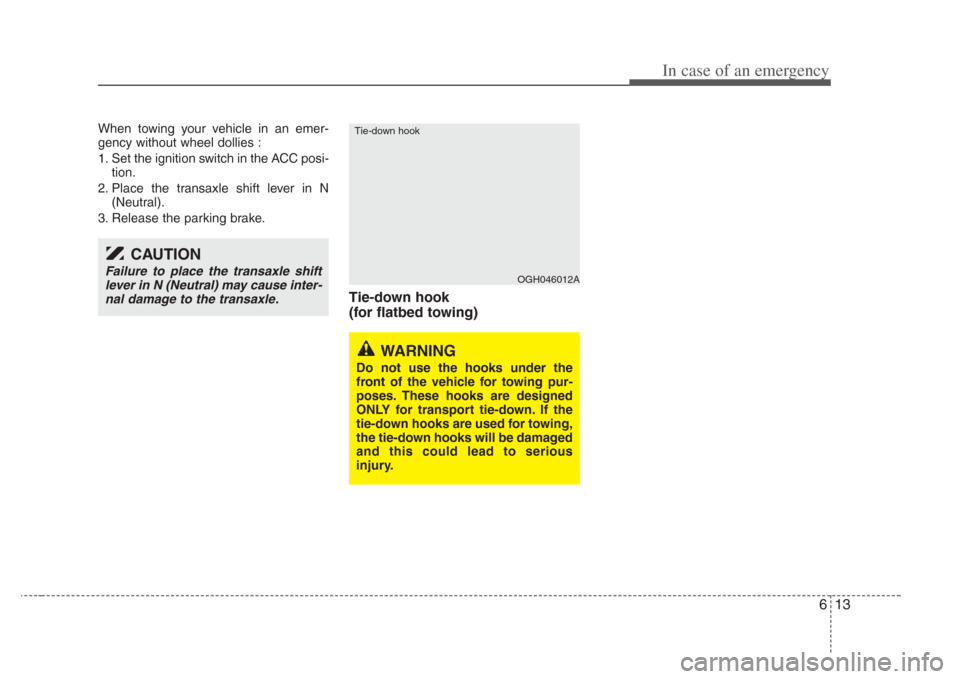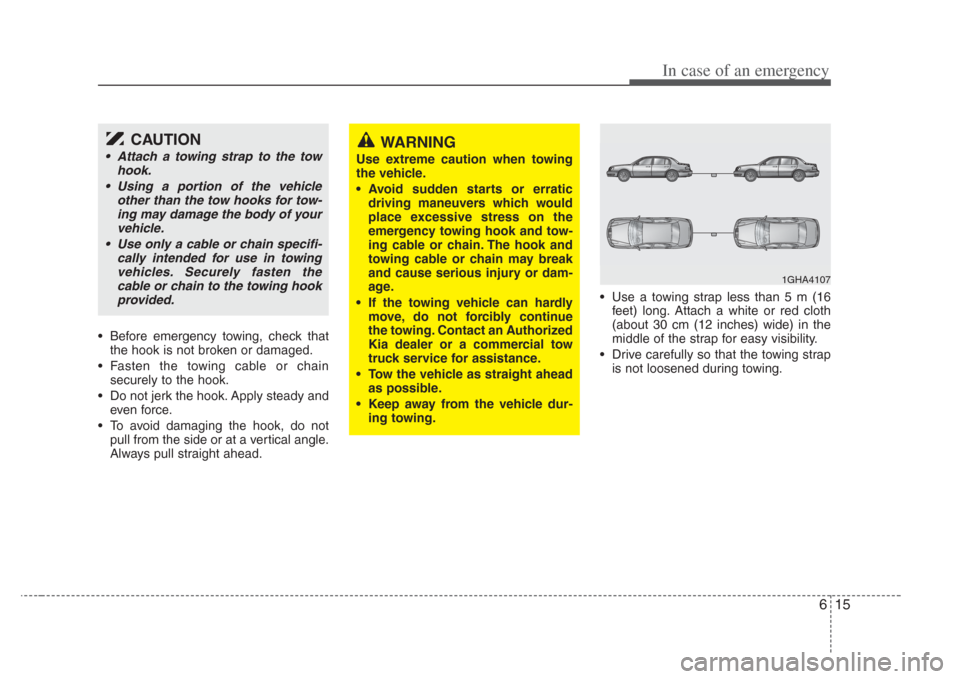2008 KIA Opirus warning
[x] Cancel search: warningPage 216 of 283

63
In case of an emergency
4. The coolant level should then bechecked. If the level in the reservoir is
low, look for leaks at the radiator hoses
and connections, heater hoses and
connections, radiator, and water
pump. If you find a major leak or anoth-
er problem that may have caused the
engine to overheat, do not operate the
engine until it has been corrected. Call
an Authorized Kia Dealer for assis-
tance. If you do not find a leak or other
problem, carefully add coolant to the
reservoir.
If the engine frequently overheats, havethe cooling system checked and repaired by an Authorized Kia Dealer.
Jump starting
Jump starting can be dangerous if done
incorrectly. Therefore, to avoid harm to
yourself or damage to your vehicle or
battery, follow the jump starting proce-
dures listed on page 6-4. If in doubt, we
strongly recommend that you have a
competent technician or towing service
jump start your vehicle.
✽
NOTICE
Use only a 12-volt jumper system. You
can damage a 12-volt starting motor,
ignition system, and other electrical
parts beyond repair by use of a 24-volt
power supply (either two 12-volt batter-
ies in series or a 24-volt motor generator
set).
WARNING- Removing
radiator cap
Do not remove the radiator cap
when the engine and radiator are
hot. Scalding hot coolant and steam
may blow out under pressure. This
could cause serious injury.
EMERGENCY STARTING
WARNING- Battery
• Keep all flames or sparks away
from the battery. The battery pro-
duces hydrogen gas which may
explode if exposed to flame or
sparks.
• Do not attempt to jump start the
vehicle if the discharged battery
is frozen or if the electrolyte level
is low; the battery may rupture or
explode.
WARNING- Battery
Never attempt to check the elec-
trolyte level of the battery as this
may cause the battery to rupture or
explode causing serious injury.
Page 218 of 283

65
In case of an emergency
Do not allow the jumper cables to con-
tact anything except the correct bat-
tery terminals or the correct ground.
Do not lean over the battery when
making connections.
5. Start the engine of the vehicle with the booster battery and let it run at 2,000
rpm, then start the engine of the vehi-
cle with the discharged battery.
If the cause of your battery discharging isnot apparent, you should have your vehi-cle checked by an Authorized Kia Dealer.
Refer to illustration on page 6-4.
Push-starting
Vehicles equipped with automatic
transaxle cannot be push-started.
Follow the directions in this section for
jump-starting.
Fuses
A vehicle’s electrical system is protected
from electrical overload damage by
fuses.
WARNING
Never tow a vehicle to s tart it
because the sudden surge forward
when the engine starts could cause
a collision with the tow vehicle.
ELECTRICAL CIRCUIT
PROTECTION
1VQA4037
Normal
Normal
Blown
Blown
Normal Blown
Page 219 of 283

In case of an emergency
66
WARNING - Fuse replace-ment
• Never replace a fuse with any-
thing but another fus e of the
same rating.
• A higher capacity fus e could
caus e damage and possibly a
fire.
• Never install a wire instead of the proper fuse - even as a temporary
repair. It may caus e extensive
wiring damage and possibly a
fire.
• Do not use a screwdriver or any other metal object to remove
fuses because it may cause a
short circuit and damage the sys-
tem.
This vehicle has two fuse panels, one
located in the driver's side knee bolster,
the other in the engine compartment
near the battery.
If any of your vehicle’s lights, acces-
sories, or controls do not work, check the
appropriate circuit fuse. If a fuse has
blown, the element inside the fuse will be
melted.
If the electrical system does not work,
first check the driver’s side fuse panel.
Always replace a blown fuse with one of
the same rating.
If the replacement fuse blows, this indi-
cates an electrical problem. Avoid using
the system involved and immediately
consult an Authorized Kia Dealer.Fuse replacement
1. Turn the ignition switch and all other switches off.
2. Pull the suspected fuse straight out. Use the removal tool provided on the
main fuse box in the engine compart-
ment.
3. Check the removed fuse; replace it if it is blown.
Spare fuses are provided in the fusepanel.
4. Push in a new fuse of the same rating, and make sure it fits tightly in the clips.
If it fits loosely, consult an Authorized Kia
Dealer.
1GHA402
Driver - side knee bolster
Page 224 of 283

611
In case of an emergency
Power connector
Your vehicle is equipped with a power connector to prevent bat-
tery discharge if your vehicle is parked without being operated
for prolonged periods. Use the following procedures before
parking the vehicle for prolonged period.
1. Turn off the engine.
2. Turn off the headlights and tail lights.
3. Open the driver-side knee bolster cover and pull up the“POWER/CONN”.
✽NOTICE
If the power connector is pulled up from the fuse panel, the
warning chime, AV system, clock and intetrior lamps, etc.,
will not operate. Some items must be reset after replace-
ment.
Even though the power connector is pulled up, the battery can still be discharged by operation of the headlights or
other electrical devices.
Des cription Fus e rating Protected component
A/CON 10A Air-conditioning system
P/WDW(LH) 20A Power window (left)
TAIL LP(RH) 10A Taillight (right)
BACK WARN’G 10A Back warning system
DR LP 10A Door courtesy lamp
MIRROR HTD 15A Outside review mirror defroster
ENG SNSR 10A
Power train control system sensors
T/REDUCER10A Seat belt tension reducer
CLOCK 10A Clock
WIPER(FR) 25A Wiper (front)
EPS 10A Electronic power steering
TAIL LP(LH) 10A Tail light (left)
ROOM LP 10A Room lamp
AV, CLOCK 15A Audio, Clock
LAN UNIT 10A Lan unit
TPMS 15A -
H/LP WASHER 20A Headlight washer
SHUNT CONN - Switch illumination
POWER/CONN - Power connector
1GHA403
Power
connector
Page 226 of 283

613
In case of an emergency
When towing your vehicle in an emer-
gency without wheel dollies :
1. Set the ignition switch in the ACC posi-tion.
2. Place the transaxle shift lever in N (Neutral).
3. Release the parking brake.
Tie-down hook
(for flatbed towing)
OGH046012A
Tie-down hook
WARNING
Do not use the hooks under the
front of the vehicle for towing pur-
poses. These hooks are designed
ONLY for transport tie-down. If the
tie-down hooks are used for towing,
the tie-down hook s will be damaged
and this could lead to s erious
injury.
CAUTION
Failure to place the tran saxle shift
lever in N (Neutral) may cause inter- nal damage to the tran saxle.
Page 228 of 283

615
In case of an emergency
• Before emergency towing, check thatthe hook is not broken or damaged.
• Fasten the towing cable or chain securely to the hook.
• Do not jerk the hook. Apply steady and even force.
• To avoid damaging the hook, do not pull from the side or at a vertical angle.
Always pull straight ahead. • Use a towing strap less than 5 m (16
feet) long. Attach a white or red cloth
(about 30 cm (12 inches) wide) in the
middle of the strap for easy visibility.
• Drive carefully so that the towing strap is not loosened during towing.
1GHA4107
WARNING
Use extreme caution when towing
the vehicle.
• Avoid sudden starts or erratic
driving maneuver s which would
place excessive stress on the
emergency towing hook and tow-
ing cable or chain. The hook and
towing cable or chain may break
and cause serious injury or dam-
age.
• If the towing vehicle can hardly move, do not forcibly continue
the towing. Contact an Authorized
Kia dealer or a commercial tow
truck service for assistance.
• Tow the vehicle as straight ahead
as possible.
• Keep away from the vehicle dur- ing towing.
CAUTION
• Attach a towing strap to the tow hook.
•U sing a portion of the vehicle
other than the tow hook s for tow-
ing may damage the body of your vehicle.
•U se only a cable or chain specifi-
cally intended for u se in towing
vehicles . Securely fas ten the
cable or chain to the towing hook provided.
Page 231 of 283

In case of an emergency
186
The compact spare should be inflat-
ed to 420 kPa (60 psi).
✽NOTICE
Check the inflation pressure after
installing the spare tire. Adjust it to
the specified pressure, as necessary.
When using a compact spare tire,
observe the following precautions:
• Under no circumstances should
you exceed 80 km/h (50 mph); a
higher speed could damage the
tire.
• Ensure that you drive slowly enough for the road conditions to
avoid all hazards. Any road hazard,
such as a pothole or debris, could
seriously damage the compact
spare.
• Any continuous road use of this tire could result in tire failure, loss of
vehicle control, and possible per-
sonal injury.
• Do not exceed the vehicle’s maxi- mum load rating or the load-carry-
ing capacity shown on the sidewall
of the compact spare tire.
• Avoid driving over obstacles. The compact spare tire diameter is
smaller than the diameter of a con-
ventional tire and reduces the
ground clearance approximately
25 mm (1 inch), which could result
in damage to the vehicle. • Do not take the vehicle through an
automatic car wash with a compact
spare.
• Do not use tire chains on this tire. Because of the smaller size, a tire
chain will not fit properly. This could
damage the vehicle and result in
loss of the chain.
• This tire should not be installed on the front axle if the vehicle must be
driven in snow or on ice.
• Do not use the compact spare tire on any other vehicle because this
tire has been designed especially
for your vehicle.
• The compact spare tire’s tread life is shorter than a regular tire.
Inspect your compact spare tire
regularly and replace worn com-
pact spare tires with the same size
and design, mounted on the same
wheel.
WARNING - Compact spare
This spare tire should be used
only for VERY short distances.
Compact spares should NEVER
be us ed for long drives or
extended distances.
Page 232 of 283

619
In case of an emergency
Changing tires
Jacking instructions
The jack is provided for emergency
tire changing only.
Follow jacking instructions to reduce
the possibility of personal injury.
Tire replacement
1. Park on a level surface and apply
the parking brake firmly.
2. Shift the shift lever into P (Park).
3. Activate the hazard warning flash- er.
WARNING- Changing tire s
• Never attempt vehicle repair s
in the traffic lanes of a public
road or highway.
•Alway s move the vehicle com-
pletely off the road and onto
the shoulder before trying to
change a tire. The jack should
be used on level firm ground
whenever possible. If you can-
not find a firm, level place off
the road, call a towing service
company for assistance.
• Be sure to use the correct
front and rear jacking po si-
tions on the vehicle; never use
the bumper s or any other part
of the vehicle for jack support.
(Continued)
(Continued)
• The vehicle can easily roll off the jack caus ing serious
injury or death. No per son
should place any portion of
their body under a vehicle that
is supported only by a jack ;
use vehicle support stands.
• Do not start or run the engine while the vehicle i s on the
jack.
• Do not allow anyone to remain in the vehicle while it i s on the
jack.
• Make sure any children pres-
ent are in a secure place away
from the road and from the
vehicle to be rai sed with the
jack.
1JBA6021